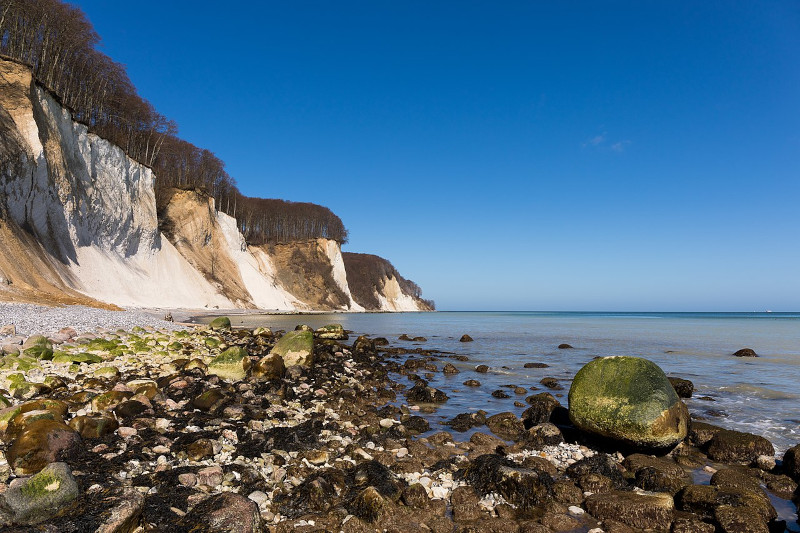
Rügen Island Facts
- The deceptively short term of Rügen Island serves as the only commonly used title for this marvelous geological formation today. It held other monikers in the past, however, in other tongues. These included Rugia, in Latin, and Rȯjana in the Rani tongue.
- Archaeological evidence indicates that humans knew of and lived on the island since the latter part of the Stone Age. That occupancy appears to have began sometime around or after 10,000 years ago. This evidence includes megalithic tombs and altars.
- Beginning in the 7th century, though, the Rani civilization built their own empire, centered on the site. For a period of time, they dominated the region. Their empire, in fact,survived until well into the 12th century. Many signs of this remain today.
- In our modern era, the stunning Rügen Island continues to garner much appreciation. Due to its great natural beauty, it forms the most popular tourist destination in the country in which it lies. Thankfully, efforts are taken to maintain its natural state.
- These efforts include the establishment of two beautiful National Parks and one extensive Nature Reserve. One of these parks, in fact, holds a special prestige. That’s because, in 2011, UNESCO named Jasmund National Park a World Heritage Site.
Related Articles
Rügen Island Physical Description
The majestic Rügen Island boasts many wonders to dazzle those fortunate enough to visit the site. Its size and shape certainly rank among these. That’s due to the combined facts that the island contains both a respectable area and a highly distinctive general shape.
In overall design, it has a slightly rectangular shape. In maximum length it measures roughly 31.94 mi (51.4 km). Its width, however, differs only slightly, at 26.59 mi (42.8 km). These dimensions provide the marvel with an area of roughly 357.7 sq mi (926.4 sq km).
Yet, it also hosts multiple sizeable peninsulas. To the north, the major one’s bear the names of Jasmund and Wittow. They’re connected by a large sandbar in places, yet separated by lagoons in others. In the south, Zudar and Mönchgut stand out for facing a large bay.
These features, themselves impressive, combined with an extraordinarily irregular outline, provide this creation of geological forces with yet another amazing statistic. That’s because it has an incredibly extensive coasline. This totals a remarkable 356.7 mi (574 km).
Yet, Nature didn’t stop there in its work with the remarkable Rügen Island. That’s true since the formation also contains numerous other marvelous natural features. Along with the aforementioned lagoons, a large number of beaches of varying sizes also dot its shoreline.
It’s perhaps best known for the presence of a certain type of cliff formation, however. On the Jasmund Peninsula, large, extensive chalk cliffs line the coast. The most famous of these holds the translated name of Kings Chair. This example reaches a height of 387 ft (118 m).
Rügen Island Location, Formation, and Ecology
The breathtaking Rügen Island formed in a region of the globe already quite famous for it abundance of magnificent geological features. That precise section of the earth therefore likely won’t surprise many people. That’s because it sits within the confines of Europe.
Being an island, though, this site obviously lies outside the continental borders themselves. Its creation placed it in the marine region that now bears the name of the Baltic Sea. Its placement puts it almost equally off the shores of the countries of Poland and Germany.
The origins of this lovely location reach far back in the past. Unlike some similar features in its part of the world, however, it’s not volcanic in nature. Instead, it owes its creation to the slow yet inexorable upward motion of tectonic activities also present in the region.
In its case, this began at some point during the late Cretaceous Period. This puts the island’s beginnings at somewhere between 72 – 66 million years ago. It’s unknown, though, at precisely what point in time the island reached the state at which it exists now.
The beautiful Rügen Island posesses a decidedly temperate, Mediterannean climate. Thus, numerous forests thrive here, primarily comprised of varieties of beech. Other trees also appear, of course, in addition to flora such as Honeysuckle and Lily of the Valley.
Multiple species of fauna also abound in this location. Large numbers of migratory birds of many types appear, such as the European Honey Buzzard. Nesting water birds also make an appearance. Insects live here in quantities, too, such as the northern dune tiger beetle.
Features Sharing Its Region
Check out our other articles on 5 Beautiful Black Sea Species, Marbled Polecat, Gobi Desert, Indian Vulture, Appalachian Avens, Lime Butterfly, Great Potoo, New Guinea Crocodile
